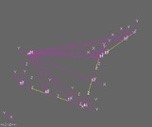Colleagues:
One of my early bosses, Wilford, introduced me to the “calibrated thumb” technique. The immediate challenge was to anticipate static deflections and resonant frequencies in new design work. His broader purpose was (I have since come to think) to open my mind about ways to develop my estimating skills. I was working in airborne IR countermeasures at the time.

I’ll introduce the technique to you with a much more recent example.
I had been called in to make dynamic boresight stability analyses for a multi-sensor suite. It was presented to me as an all-up finite element solid model of the system with three million-plus degrees of freedom. I incorporated Ivory’s optomechanical constraint equations to calculate the line-of-sight errors for each sensor and the boresight errors between them. This unified optomechanical model passed the rigid-body checks and static gravity checks just fine. The calculated boresight errors were small compared to the specification.
But I had an uneasiness. There are lots of places in complex models to enter typos, select the wrong property from a long list or drop some decimal places. How can I settle my uneasiness about someone else’s model? My client had been around a while and done a lot of good stuff in the past, so I got an idea.

I went out to their shop where a variety of
similar sensor systems were sitting on granite surface plates. I got a
height gage with a digital indicator and set it next to one of the
systems. Then I pushed on the system with my thumb applying what I
thought to be about 1.0 pound and observed the deflection under the digital
indicator’s tip. I repeated it with two other sets of hardware in the
shop. The deflections were all somewhat different. That was
expected since the systems were of substantially different sizes. But
they’d all been designed and built by this organization.
Then I did a thought experiment, “If I push on the unified model with my thumb how much
deflection should I expect?”
I went back to my computer and applied a similar load to the model. The
computed response compared well to my thought experiment. My anxiety
eased and the model proved, in test, to be reasonably accurate. Whew!
A calibrated thumb is a good thing to have. Thanks, Wilford.
Of course, my calibrated thumb is one of the tools I try to keep sharp.
When I got back to my home office I checked my thumb with a postal package
scale.
Use it or loose it!
Al H.
1-29-15













